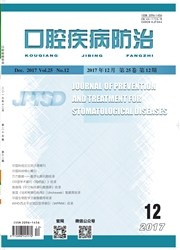

 中文摘要:
中文摘要:
目的:对比埋植型与非埋植型种植义齿受载后种植体-牙骨界面中白细胞介素-6表达变化的异同.方法:选用纯种Beagle犬8只,在其下颌骨分别植入埋植型与非埋植型种植体,3个月后行固定金属全冠种植义齿修复,按不同时期处死动物,采用免疫组化法对比不同时期的埋植型与非埋植型种植体-骨界面中白细胞介素-6表达变化的异同.结果:实验组种植体-骨界面的白细胞介素-6水平于2周时较对照组明显增加,且均于4周时达到峰值,12周时恢复至对照组相似水平.埋植型与非埋植型种植体之间无明显差异(P>0.05).结论:机械应力通过埋植型与非埋植型种植义齿传递至种植体-骨界面,均刺激白细胞介素-6的表达.
 英文摘要:
英文摘要:
Objective:To compare the difference in Interleukin-6 (IL-6) expression during implant-bone interface remodeling after loading of submerged and non-submerged implant dentures. Methods: Eight adult beagle dogs were subject to implantation of submerged and non-submerged implants to the bilateral mandible bone, which entailed restored procedures by using fixed metal full crown at month 3. The dogs were sacrificed for measurement of the expression of IL-6 on the implant-bone interface at different time points, which allowed comparison between submerged and non-submerged implants by using immunohistoehemistry assay. Results: The level of IL-6 in experimental groups was significantly higher than that in control group at week 2, which culminated at week 4 and declined to the level similar with the control group at week ~2. No significant difference in the expression of IL-6 was noted between submerged and non-submerged implant dentures ( P 〉 0.05 ). Conchmion: The occlusive force which transfers from the implant-bone interface of the submerged and non- submerged implant dentures leads to augmented IL-6 expression.
 同期刊论文项目
同期刊论文项目
 同项目期刊论文
同项目期刊论文
 期刊信息
期刊信息
